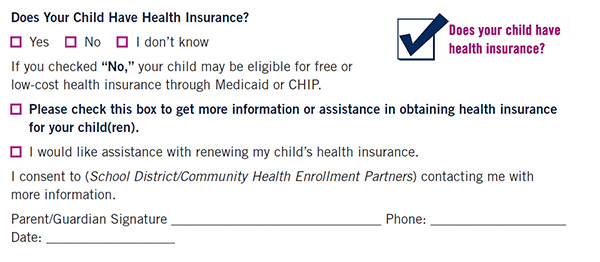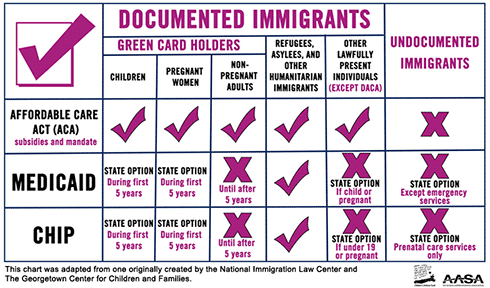For some time, my parents were undocumented, struggled financially and did not always have access to basic services, such as medical care. We did not have preventive care, rather we visited doctors and clinics when something wasn’t feeling right and the pain just wouldn’t go away. There were times, where for different circumstances, i.e. lack of transportation, urgent needs made us take drastic measures. For example, I remember walking into someone’s garage for dental treatment. That memory stayed with me, as it was something that just didn’t look right — it had all of the furnishings but it was inside a garage. Unfortunately, we were not the only family there, others were also visiting and using these services.
Why
Why Must Uninsured Children Be Identified and Enrolled? Health affects every aspect of a child’s life — including the ability to grow, learn, play and succeed. Academic achievement and health are closely linked. Children who cannot focus due to a toothache or who don’t have the needed glasses to see the chalkboard or hearing aids to hear their teachers and classmates are less likely to achieve in the classroom. Children with health insurance are better equipped to handle health-related issues such as chronic illness, hunger and physical or emotional abuse — which untreated can lead to poor academic performance.12 Children are more likely to have health insurance if their parents do,13 and insured children are more likely to experience educational success and overall well-being than their uninsured peers.14 As a trusted community partner, schools can play a unique role in identifying uninsured children and families and connecting them to health insurance.
Who
Who Are the Uninsured Children? While our country has made incredible progress expanding health coverage for children, nearly 4.5 million children under age 18 (6 percent) remain uninsured — one in seventeen. School-aged children (ages 6-17) are more likely than younger children to be uninsured, and account for nearly three out of four uninsured children in the nation. Hispanic children are uninsured at a higher rate than White children (9.7 percent compared to just 4.6 percent). Children living in families on the brink of poverty and children living in the South and in rural areas are also less likely to be insured than those living in other parts of the country. More than 90 percent of uninsured children are U.S. citizens and nearly 90 percent live in families with at least one working family member.15 However more than 60 percent of uninsured children — 2.8 million — are eligible for health coverage through Medicaid or CHIP.16
What is the Health Insurance Landscape for Children?
Find Out

How
Identifying Uninsured Children in School Settings: CDF and AASA's School-Based Approach
CDF and AASA’s tested model provides school districts a basic question to add to their school registration materials: “Does your child have health insurance?" Children whose parents answer “no" or “I don’t know" and give their permission can then be contacted for application assistance.
How Can Your School District Add the Question to Annual School Forms and Identify Uninsured Children?
- Estimate the Number of Uninsured Children. Determining the number of uninsured children living within your schools district's boundaries is essential for making the case to your school district leadership about the need to engage in this work. Once done, reasonable targets can be set for the number of uninsured children you seek to enroll. Learn how to obtain data from the U.S. Census Bureau to estimate the number of uninsured children in your school district.
- Add a Health Insurance Question. Work with your team to develop and add a question about health insurance to a form parents are already required to complete annually. Is it the school enrollment form? Registration form? Emergency or health card? Use the CDF/AASA Health Insurance Template to determine the best language for your school district. Be sure to also include language obtaining parental permission to contact them to follow up about health insurance.
- Use the School District's Data System. Once the mandatory form has been filed by the parent or guardian, it’s critical that the district office(s) transfer any data captured on paper into the district’s electronic records system. Maintaining up-to-date information in a safe and secure database that allows key school personnel to access the data will yield better and more coordinated action. For districts that already have electronic enrollment systems and require parents to enroll their students online, consider making the question about health insurance a mandatory field to ensure all parents report their child's insurance status.
- Don't Forget About Special Populations. Some of the most vulnerable children in your school district may still be uninsured. You can work within your existing programs and services to reach out to these children and families and inquire about health insurance. Some examples of special populations include:
- Homeless children and children in foster care. Consider options to reach homeless children and those in foster care through your district's homeless liaisons and foster care points of contact, partnering with service agencies and providers, and adapting any special intake forms your district may already use with these students.
- Pregnant and parenting teens. Does your district have special programs for pregnant and parenting teens? If so, these programs present an opportunity to inquire about health insurance and help connect not only the young parents, but also their newborns.
- Children from immigrant families. Immigrant children are more likely to be uninsured, and their families may be unaware of programs for which their child may be eligible. Undocumented parents may be hesitant to apply for insurance for their child even if their children are citizens, out of concern about deportation. Often schools are trusted messengers for these immigrant families and can play an important role in educating immigrant families about their child's health insurance options. However, this can be very confusing; so this special excerpt may be helpful.
- Children of school district employees. There may be district employees with children who are eligible for but not enrolled in health insurance. Share information about outreach and enrollment opportunities with your part-time and hourly waged employees including food service workers, custodial staff, bus drivers and others who may not have access to employer-sponsored health insurance for themselves or their dependents.
Story
Martin arrived in Compton, California as an unaccompanied minor without health insurance. His nomadic journey across America included violence, poverty and separation from his mother and siblings. When Martin enrolled in the Compton Unified School District, a staff member connected him to a social worker. As an unaccompanied minor, the district provided gift cards for clothes and food, helped him get eyeglasses and health insurance. With his new insurance, Martin was able to receive the therapy he needed to address the trauma from the violence and his multiple relocations. He credits his successful graduation from high school with honors and admission into 11 universities to the support he received from the school district. Martin is now following his dream of becoming a college graduate and creating a better life for himself and his family.

How Does Immigration Status Impact Eligibility for Health Insurance?
Immigration status is a critical factor in eligibility for health insurance. While there are some federal guidelines states must follow in setting eligibility rules for public coverage, states also have some flexibility. As a result, eligibility differs from program to program and state to state. Because schools enroll all children regardless of immigration status, they are particularly well suited to communicate with undocumented families. It is very important to remind parents they do NOT have to disclose their own immigration status when enrolling an eligible child, and that information they share when applying is not to be used by immigration officials. The chart details eligibility for health insurance programs by immigration status.18
School Districts and Parental Permission to Share Data
When seeking to enroll uninsured children in health insurance, it is a common practice for schools to work with external partners and agencies. Therefore, it is very important that school personnel understand the importance of parental consent and put into place the necessary protections for data sharing. Patient health care records maintained by schools are considered education records and are subject to the Family Educational Rights and Privacy Act (FERPA)19 and not the privacy portions of the Health Insurance Portability and Accountability Act (HIPAA).20 Under FERPA, a school district may disclose personally-identifiable information from a pupil record with written consent from a parent, guardian or adult pupil. Therefore, when amending forms to add a question about health insurance, we recommend adding an additional question regarding parental consent immediately following it. The Department of Education has developed a data-sharing toolkit that helps simplify the concepts of FERPA and its parameters relative to the sharing of personally identifiable information from education records.21 HIPAA generally covers medical information maintained by or for what is called a “covered entity.“ The two types of covered entities under HIPAA of interest here are health coverage plans (like Medicaid or CHIP) and health care providers (like a doctor or hospital). HIPAA’s privacy rule requires covered entities to protect health records and other identifiable health information by using safeguards like requiring a child’s parent or guardian to sign before sharing a copy of health records with anyone. HIPAA also gives parents rights over their child’s health information, including the ability to obtain a copy of their child’s health records and correct any misinformation. Watch this two minute informational video from the U.S. Department of Health and Human Services to learn more about HIPAA.
Houston Independent School District, Texas
Houston ISD’s Coverage Map was a result of the district’s interest in expanding health services throughout their schools in a cost effective manner. The size of their district (283 schools, 215,000 students) and the variety of partners and community services working with them made it important to develop a visual perspective to identify areas of greatest need. The Manager of Health and Medical Services met with Houston ISD’s demographer to discuss the vision and provided specific information about existing health services and their target areas.
After the mapping exercise, Houston ISD was better able to visualize the areas of their district that lacked access to services as well as those receiving overlapping services. With this information in hand, the district identified target areas for improving health care access for children and families through outreach, application assistance and other direct service support. The district was also better prepared to seek grant funding to support the needs of students within underserved areas.22

The Children’s Defense Fund Leave No Child Behind® mission is to ensure every child a Healthy Start, a Head Start, a Fair Start, a Safe Start and a Moral Start in life and successful passage to adulthood with the help of caring families and communities.
CDF provides a strong, effective and independent voice for all the children of America who cannot vote, lobby or speak for themselves. We pay particular attention to the needs of poor children, children of color and those with disabilities. CDF educates the nation about the needs of children and encourages preventive investments before they get sick, drop out of school, get into trouble or suffer family breakdown.
CDF began in 1973 and is a private, nonprofit organization supported by individual donations, foundation, corporate and government grants.

AASA, the School Superintendents Association, represents, works alongside, supports, and is the voice of superintendents and education leaders across the United States. Thirteen thousand strong and 151 years old, we remain committed to excellence and equity for each and every child in public schools. Leveraging our 49 state affiliates and national partners, we focus on developing school system leaders who can meet the challenges facing 21st century students and beyond.

